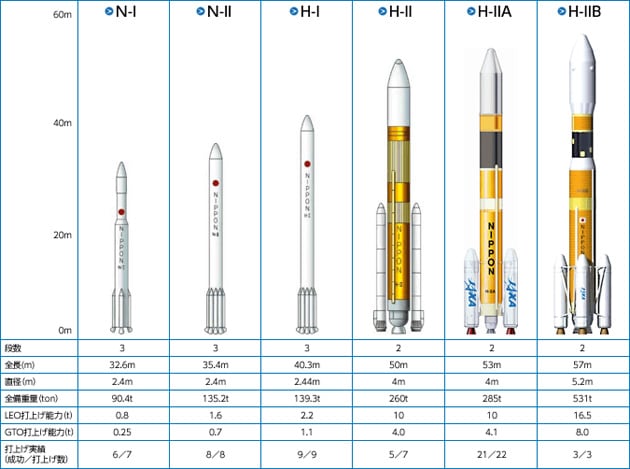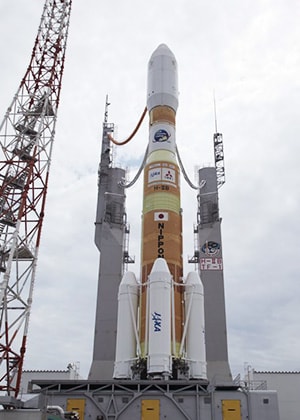
- Semiconductor Technology Now
Technology
Achieving World's Highest Level of Reliability
So far, we've reviewed the development path of solid-fuel rockets in Japan that started at the University of Tokyo's Institute of Industrial Science and was followed by the Institute of Space and Astronautical Science (ISAS). But there was also a separate development path for liquid-fuel rockets, which came under the purview of the National Space Development Agency of Japan (NASDA). The agency was established in 1969, a year before ISAS successfully launched a satellite.*1
Liquid-fueled engines are structurally more complex than solid-fueled ones, and they also take longer and cost more to develop. The risk of launch failure is naturally higher, especially for a country like Japan that had little experience in developing liquid-fuel rockets and hadn't amassed much technological know-how.
That is why NASDA chose to acquire technologies from the U.S. The downside was that the core technologies would remain classified and undisclosed to NASDA, which meant the Japanese team might not be able to handle the situation by themselves if a critical issue were to occur. But the advantage of faster completion of rockets outweighed those concerns. Also, early launches would give the team much needed operational experience and skills.
It was in 1970 that the development of the N-I rocket started applying America's Delta rocket technology. The first launch of N-I took place only five years later in 1975. The inaugural flight of the succeeding N-II rocket took place in 1981, followed by the launch of H-I (the first of the current H series) in 1986. In this short period, the rockets grew steadily larger.
 |
The first completely Japanese-made liquid-fuel rocket was H-II, which succeeded H-I. The second-stage booster made domestically for the H-I rocket was adopted again, to which a larger first-stage booster newly developed in Japan was added. The H-II development program started in 1986 and a test vehicle was successfully launched in 1994, overcoming many difficulties including an engine explosion incident.
But the true pain of labor was yet to come. After three successful test vehicle launches, H-II continued its streak of success until the sixth launch in 1998 (vehicle No. 5), when a trouble occurred in the second-stage booster. The combustion time was cut short, resulting in a failure to deliver the payload satellite into orbit.*2
Everyone worked hard to ensure the next launch in 1999 (vehicle No. 8) would go without a hitch, but the first-stage booster developed a trouble during the flight and stopped functioning. As there was no chance of delivering the satellite into orbit, the control center sent a self-destruct command to the rocket. The all Japanese-made rocket program thus suffered two failures in a row.
Reliability is as crucial to a rocket as high specs. The launch success rate of 95% is considered adequate, but the two failures brought H-II's success rate down to 71.4%.
In contrast, the launch success rates for the N-II and H-I rockets were both 100%. These figures may appear to suggest that the new policy of turning to entirely Japanese-made rockets was misguided: but such a conclusion is premature. The use of proven American technologies had naturally reduced the risk of failure, but that advantage was destined to vanish once NASDA had chosen to go for purely home-grown technologies. It was inevitable that the launch success rate would suffer, at least over the short term.
| Rocket | N-I | N-II | H-I | H-II | H-IIA | H-IIB | |
|---|---|---|---|---|---|---|---|
| First flight | 1975 | 1981 | 1986 | 1994 | 2001 | 2009 | |
| Length | 32.6m | 35.4m | 40.3m | 50m | 53m | 56.6m | |
| Outer diameter | 2.44m | 2.49m | 4m | 5.2m | |||
| Weight | 90.4t | 135.2t | 139.3t | 260.0t | 289t | 531t | |
| Stages | 3 | 2 | |||||
| Engine | 1st stage | MB3-3 | LE-7 | LE-7A | |||
| 2nd stage | LE-3 | AJ-10 | LE-5 | LE-5A | LE-5B | ||
| 3rd stage | Star 37N | Star 37E | UM-129A | - | |||
| Booster | Castor II | SRB | SRB-A | ||||
| Launch capacity | LEO | 0.8t | 1.6t | 2.2t | 10t | 10t | 16.5t |
| GTO | 0.25t | 0.7t | 1.1t | 4t | 4t | 8t | |
| Number of vehicles launched | 7 | 8 | 9 | 7 | 22 | 3 | |
| Success rate | 85.7% | 100.0% | 100.0% | 71.4% | 95.5% | 100.0% | |
 |
Another H-II rocket (vehicle No. 7) was scheduled for launch, but the plan was reexamined and scratched. Instead, NASDA chose to focus on the improved H-IIA rocket that had been in development since 1996.
The first H-IIA test rocket was launched in 2001, and subsequent launches were also successful except for vehicle No. 6 in 2003. As of April 2013, 21 out of 22 launches were successful, with the success rate of 95.5% which is among the highest in the world. The H-IIB rocket that doubled the first stage engines was completed in 2009, and three consecutive launches have been conducted successfully to date.



















